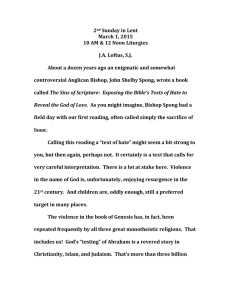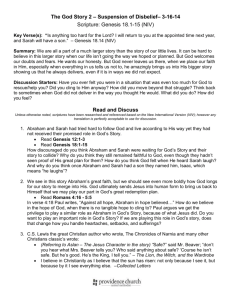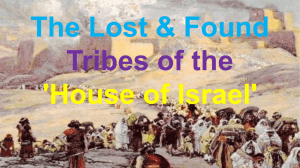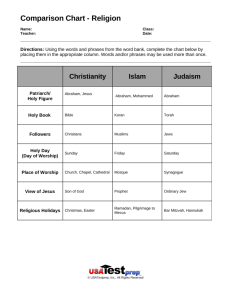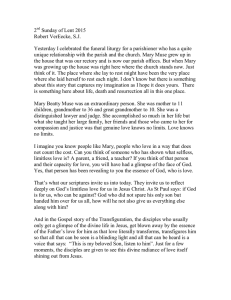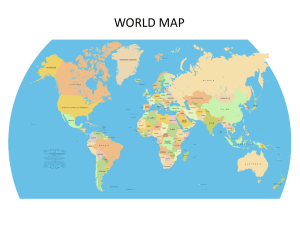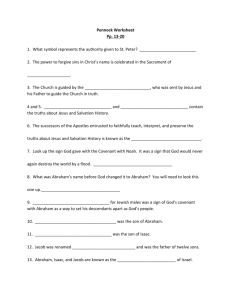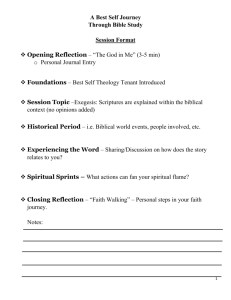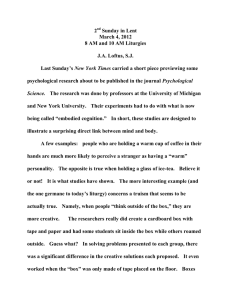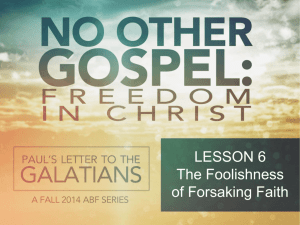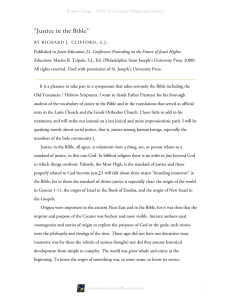Second Sunday in Lent March 8, 2009
advertisement
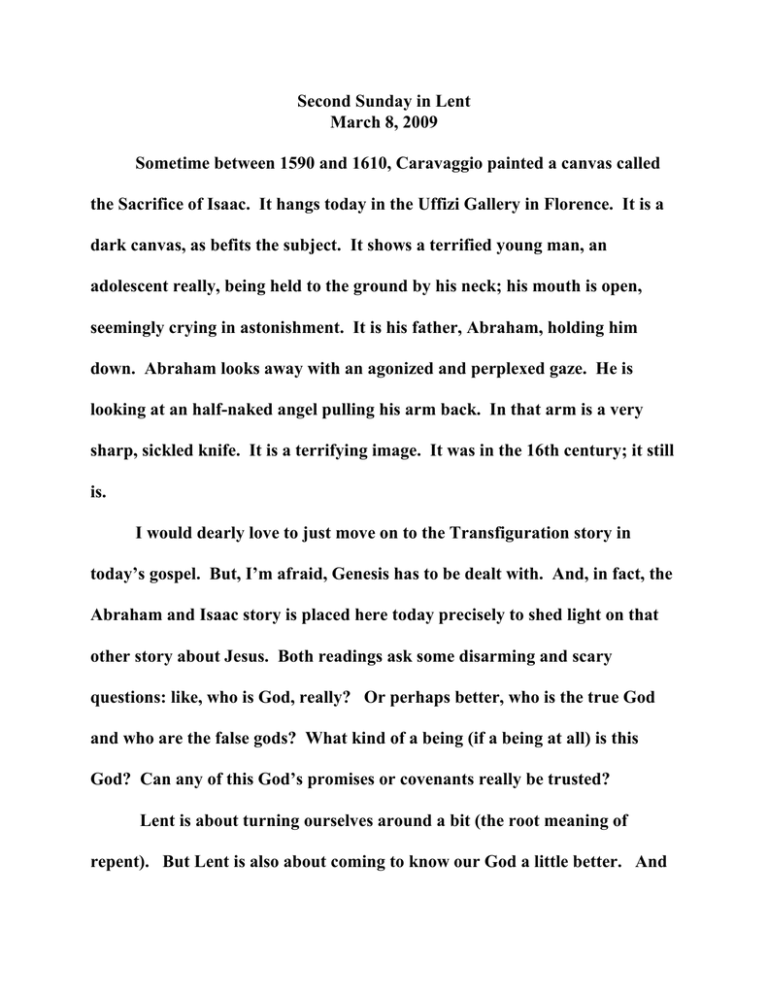
Second Sunday in Lent March 8, 2009 Sometime between 1590 and 1610, Caravaggio painted a canvas called the Sacrifice of Isaac. It hangs today in the Uffizi Gallery in Florence. It is a dark canvas, as befits the subject. It shows a terrified young man, an adolescent really, being held to the ground by his neck; his mouth is open, seemingly crying in astonishment. It is his father, Abraham, holding him down. Abraham looks away with an agonized and perplexed gaze. He is looking at an half-naked angel pulling his arm back. In that arm is a very sharp, sickled knife. It is a terrifying image. It was in the 16th century; it still is. I would dearly love to just move on to the Transfiguration story in today’s gospel. But, I’m afraid, Genesis has to be dealt with. And, in fact, the Abraham and Isaac story is placed here today precisely to shed light on that other story about Jesus. Both readings ask some disarming and scary questions: like, who is God, really? Or perhaps better, who is the true God and who are the false gods? What kind of a being (if a being at all) is this God? Can any of this God’s promises or covenants really be trusted? Lent is about turning ourselves around a bit (the root meaning of repent). But Lent is also about coming to know our God a little better. And today we get to peek at the Godhead itself. What does God look like? Where are God’s footprints, as the Psalmist asks? How does God act–especially towards us? Big questions; little time. But let’s try. On first bounce, today’s Genesis reading about Abraham’s call to sacrifice his son and heir Isaac, seems sadistic and cruel. Did I say “seems”? No, it is sadistic and cruel. This is the portrait of a capricious and malevolent God with whom most of us would not want to deal. That’s how most of us really do feel, I think, even though we try to form neater and more spiritual explanations for what’s happening here. But it is hard to comprehend this God. It’s not a nice picture! God is “testing” and tormenting Abraham, his chosen servant. What makes this scene from Genesis so troubling today is that it is not just an historical or allegorical scene from the past. It is happening again and again in our own time. Children are still being sacrificed all around our world before strange images of gods. Children fly planes-full of people into World Trade Center towers. In the name of god. Children strap explosives onto their chests and murder thousands of innocent people. In the name of god. What could cause human beings to think that god wanted them to do these things? 2 The violence of the book of Genesis is repeated daily and in all three of the great monotheistic faiths. God’s testing of Abraham is a revered story in Christianity, Islam, and Judaism. (Note though that for Muslims it is Ishmael not Isaac who is held to the ground by the knife.) But that represents three billion of the earth’s population, and we all have this story in common. My brothers and sisters, this is a crucial text to get right. Lives still depend on it. (In this morning’s Boston Globe, Philip Jenkins has a story called “Dark Passages” that comes to much the same conclusion. Thousands of years after this story was first written down, we may finally have some clues with which to interpret the story. Did the story-teller in Genesis simply get it wrong? Does God–the true God–ever ask us to do anything so terrible as to sacrifice our children? Did the true God ever even ask Abraham to do this? There is a fascinating hint in the original text itself. There are two different gods that appear in this story. The one at the beginning of the story, in verses 1 and 12, is called Elohim, the earliest Jewish name for god. This word, in its simplest form, El, as in Beth-el, meaning House of God, is also the word used for all the other gods, the gods of the pagans, or the heathen, the gods who still demand human sacrifice. It describes the “false gods.” In versus 11 and 14, however, the name of god 3 switches to Yahweh. This is the distinctive Hebrew name for God which became so special for the Jewish people that they dared not even speak it or write it. Instead they will say “Lord,” or Adonai. Why is this hint by the author of Genesis so important? Because the name the one, true God of Israel gives when God speaks to Moses before the burning bush is Yahweh, I am who am. That is the name of the One God of Israel for eternity. It is the special name of God that the Hebrew people have to give the world. It is not the true God who asks Abraham to sacrifice his son. It is the true God of Israel who tells him to stop. And to stop forever. God has no part in violence–period! And the voice of the true God of Israel is heard again today in Mark’s gospel. The question is still the same as the one in Genesis: who is the true God of all peoples and what does that God ask of us? And in a blinding moment of revelation, the true God of Israel answers the question clearly: “This human being–like yourselves in all ways–this man is my Beloved. Listen to him.” When Matthew and Luke tell their versions of this story, they both comment on Jesus’ face being transformed. And there we see it: for all eternity the face of God is human. That must have come as a revelation not 4 only for Peter, James and John, but for Jesus himself. And it is still a revelation for us–one we find too hard to believe. The human is transfigured in God. And no more sacrifice is ever required. Jesus is led to Jerusalem to banish death and violence forever! Jesus “morphed” on that mountain into who he really was–into who he really is–into who we all are now because of him. We’re even using that word again in contemporary vocabulary, morphed. And it is the word used in the gospels: metamorphase is the Greek for transfiguration. Mary Oliver has a poem that speaks well of what today’s experience is. It is part of a poem with the intriguing title: “The Vast Ocean Begins Just Outside our Church: The Eucharist.” (There’s another whole homily in there!) She says: “I want to see Jesus, maybe in the clouds, or on the shore just walking, beautiful man and clearly someone else besides. On the hard days I ask myself if I ever will. Also there are times my body whispers to me that I have.” (Thirst, 24) Transfiguration moments are for us. And they are in us. They are us. 5
